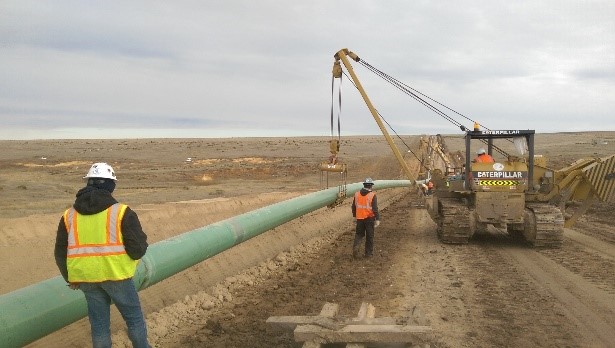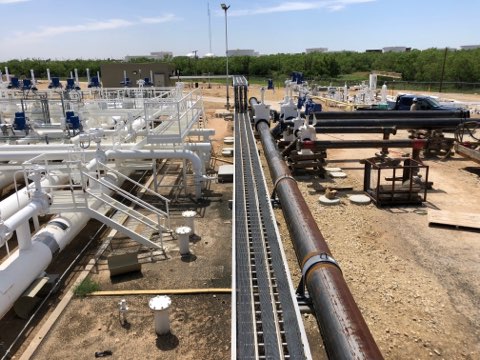Meet the Team Behind the Innovation: Spotlight on Creek Pipe Midland
Wiki Article
A Comprehensive Overview to Understanding Pipelines and Their Role in Building and construction
Pipes are important parts in building and construction, offering essential functions in water, waste, and gas administration. Their option and application can significantly affect a building's efficiency and safety and security. Various products, such as PVC, copper, and PEX, provide distinctive advantages suited to details demands (Creek Pipe Midland). Understanding these elements is vital for any kind of building and construction task. As one discovers the ins and outs of pipes, the implications for conformity and public health come to be significantly evidentThe Importance of Water Lines in Construction
Pipes function as necessary conduits in building and construction, promoting the activity of water, gas, and waste throughout structures and infrastructure. Their duty prolongs beyond plain transport; they are vital for guaranteeing the capability and security of business and property settings. Effectively installed pipelines contribute to the reliable distribution of sources, allowing daily tasks such as food preparation, showering, and home heating. Pipes play a critical role in waste management, making certain that sewage and wastewater are efficiently gotten rid of from living spaces.The significance of pipes is additionally mirrored in their effect on public health and wellness. Malfunctioning or insufficient piping systems can cause contamination and harmful conditions, making top quality products and installation techniques imperative. Additionally, pipes have to adhere to different building ordinance and laws, which are created to secure both occupants and the setting. The value of pipelines in construction includes both sensible functionality and vital health and wellness factors to consider.Kinds Of Pipeline Utilized in Structure Projects
Numerous kinds of pipes play a substantial function in structure tasks, each created to meet specific demands and applications. Amongst one of the most commonly made use of pipe types are PVC, which is resistant and light-weight to corrosion, making it perfect for drain and vent systems. CPVC pipes, comparable to PVC, can stand up to higher temperatures, commonly used in hot water systems. Copper pipelines are recognized for their durability and dependability, often used in pipes and heating applications. Galvanized steel pipelines, while much less usual today, were once a criterion for supply of water lines as a result of their strength. Additionally, PEX (cross-linked polyethylene) pipes are gaining appeal for property plumbing due to their versatility and resistance to scaling and chlorine. Cast iron pipes are favored for their sound-dampening residential properties, generally utilized in waste and soil systems. Each pipe type offers unique features, ensuring effective operation in building jobs.Common Materials for Pipes and Their Feature
In construction, the selection of pipe products is crucial for making sure durability and performance. Metal pipelines offer stamina and resistance to high stress, while plastic pipes provide lightweight and corrosion-resistant choices. Compound pipes integrate the benefits of both materials, making them flexible options for different applications.Steel Pipeline Options
Steel pipelines are important elements in building and construction, using a variety of choices that cater to environmental problems and various applications. One of the most typical materials consist of steel, copper, and cast iron. Steel pipes are recognized for their strength and sturdiness, making them ideal for high-pressure applications. Copper pipes are preferred for their deterioration resistance and antimicrobial homes, frequently used in plumbing systems. Cast iron pipes provide exceptional sound insulation and are suitable for waste and drainage systems. Each metal type has distinctive advantages; as an example, galvanized steel can withstand rust, while stainless-steel supplies premium deterioration resistance. Selecting the ideal metal pipeline depends on aspects such as price, ecological direct exposure, and the particular needs of the construction job.
Plastic Pipe Advantages
Plastic pipes have gotten appeal in building and construction as a result of their light-weight nature and versatility. These pipes, made from materials such as PVC, CPVC, and PE, deal excellent resistance to deterioration and chemical damages, making them suitable for different applications. Their ease of installment further boosts their allure, as they can be cut and joined without unique devices. Furthermore, plastic pipes are normally extra affordable compared to metal choices, adding to reduced general project expenses. Their smooth indoor surface areas minimize friction and boost circulation prices, while insulation properties aid keep temperature control in plumbing systems - Creek Pipe Pipeline Construction. With a variety of configurations and sizes offered, plastic pipes effectively satisfy the diverse demands of modern construction tasksComposite Pipe Characteristics
Compound pipes incorporate different materials to utilize their private toughness, leading to boosted performance and sturdiness. Generally, these pipelines include layers that may include steels, plastics, and ceramics, each contributing special properties. The internal layer might be made of a corrosion-resistant material, while the outer layer provides stamina and effect resistance. This combination enables composite pipes to stand up to severe temperatures and pressures, making them suitable for a vast array of applications, including water system and commercial procedures. Additionally, composite pipelines are commonly lighter than conventional products, facilitating simpler handling and installment. Their convenience and flexibility to various settings make them a recommended choice in modern construction projects, guaranteeing durability and effectiveness in fluid transport systems.Applications of Pipes in Plumbing Systems

Electric Avenues: The Role of Piping in Electrical wiring
In modern construction, electrical channels play an important duty in ensuring the risk-free and efficient routing of electric wiring throughout structures. These pipes supply a protective pathway for electric cables, protecting them from physical damages and ecological factors. Different materials, such as PVC, steel, and versatile channels, are utilized depending on the specific demands of the installation.Furthermore, channels assist in arranging circuitry systems, decreasing the danger of electric dangers like short circuits or fires. They likewise facilitate less complicated upkeep and upgrades, as wires can be accessed and changed without significant interruption to the structure.Proper installation of electric conduits is crucial for compliance with building ordinance and safety and security policies. This organized technique not just improves the durability of the electric system yet also adds to the total security and functionality of the building, making electrical conduits vital in modern building practices.Choosing the Right Pipeline for Your Project
Exactly how can one ensure the ideal pipeline choice for a construction job? The option process begins with comprehending the details needs of the project, consisting of the sort of fluids being transported, stress scores, and environmental problems. Product alternatives, such as Steel, copper, and pvc, ought to be examined based upon toughness, corrosion resistance, and thermal properties.Next, one must consider the pipe's size and circulation ability to establish effective operation. Regulatory criteria and codes must also be followed, as they dictate the acceptable materials and practices for particular applications. Consulting with experts and utilizing comprehensive resources can even more aid in making informed decisions.Finally, evaluating the cost-effectiveness of various alternatives is vital, stabilizing first costs with long-term maintenance and substitute prices - Creek Pipe Company. By diligently analyzing these variables, one can with confidence pick one of the most suitable pipe for their construction task, ensuring both performance and compliance
Maintenance and Assessment of Water Lines in Building
Appropriate selection of pipelines establishes the foundation for their lasting performance, making upkeep and assessment essential components in building and construction. Regular upkeep warranties that any kind of possible problems, such as leakages, corrosion, or obstructions, are recognized and resolved without delay, decreasing costly repairs and job delays. Scheduled evaluations, including aesthetic analyses and stress examinations, play an essential duty in reviewing the honesty of pipe systems.Additionally, keeping an eye on ecological elements, such as temperature variations and dirt conditions, can aid prepare for deterioration. Using innovative modern technologies, such as CCTV for interior assessments, can boost the performance of upkeep efforts. It is vital to record assessment findings and maintenance activities to develop a thorough background of the pipeline systems. By focusing on upkeep and inspection, construction professionals can prolong the life expectancy of their piping systems, ensuring they operate successfully and accurately throughout the job's duration.Frequently Asked Inquiries
Just How Do Pipes Affect Energy Performance in Buildings?
Pipes significantly affect power effectiveness in structures by regulating heating and cooling systems. Appropriate insulation and products minimize power loss, while reliable pipes styles lessen water use, ultimately bring about reduced power consumption and operational prices.What Regulations Govern Pipeline Installment in Building?
Rules regulating pipe installation in building typically include local and national structure codes, pipes codes, and safety and security requirements. These guarantee conformity with architectural honesty, material specs, and health and wellness needs, promoting security and effectiveness in construction practices.Can Pipeline Be Recycled After Usage?
The concern of pipe recyclability is substantial. Several materials, such as metal and specific plastics, can be reused successfully. However, the problem and kind of pipeline influence recycling expediency, requiring proper assessment before disposal.
Just How Do Weather Condition Problems Influence Pipe Efficiency?
Climate condition considerably influence pipeline performance. Severe temperature levels can trigger growth or tightening, while moisture may cause corrosion. Furthermore, hefty precipitation can raise soil pressure, influencing stability and overall performance of the piping system.What Are the Indicators of Pipe Failing to Look For?
Signs of pipeline failure consist of leaks, unusual sounds, discoloration of water, lowered water pressure, and noticeable deterioration. Routine assessments can help identify these issues early, protecting against costly repair services and making certain system performance in the long-term. Pipes play a critical role in waste management, ensuring that sewage and wastewater are efficiently eliminated from living spaces.The value of pipes is likewise reflected in their impact on public health and wellness. In construction, the selection of pipeline materials is important for making sure longevity and capability. Steel pipes use toughness and resistance to high stress, while plastic pipes supply light-weight and corrosion-resistant alternatives. Furthermore, pipes are used Creek Pipe Pipeline Construction to remove wastewater, linking bathrooms, sinks, and drains pipes to metropolitan sewer systems or septic tanks.Different types of pipes, such as PVC, copper, and PEX, are selected based on aspects like longevity, cost, and certain application requirements. Exactly how can one ensure the appropriate pipe option for a construction project?Report this wiki page